In today’s world, sustainability is not just an option, but a necessity. Embracing Mother Earth’s gentle ways can be fulfilling and therapeutic. And what better way than to utilize upcycled materials to create your very own, micro-greenhouse? A micro-greenhouse is a compact, self-sufficient structure that provides optimal conditions for plant growth. Equally important, upcycling is an incredible way to repurpose and reuse materials that would otherwise end up in landfills. Here are eight upcycled materials to help kickstart your micro-greenhouse journey.
Upcycled Wooden Pallets
Wooden pallets are versatile and robust, making them excellent for the foundational structure of your micro-greenhouse. These pallets, previously used for shipping goods, have a lot of life left in them. With a touch of creativity, you can convert them into sturdy, rustic, and eco-friendly greenhouse frames. Search through Pinterest’s extensive library, and you will find countless design inspirations. From minimalistic rectangular greenhouses to exotic dome-shaped structures, the possibilities are endless.
Repurposed Windows and Glass Doors
Consider using old windows and glass doors for the walls and roof of your micro-greenhouse. These not only allow for adequate sunlight but also give your structure a vintage charm. Safety is critical while upcycling these materials. So, refer to resources like Fine Homebuilding that provides insights on how to safely and competently repurpose glass structures.
Recycled Plastic Bottles
Would you believe that those discarded plastic bottles can make excellent panels for your greenhouse? Yes! Arranging them in a specific pattern can create a solid wall, letting light permeate effectively. Besides being a great way to upcycle, this method adds an interesting visual element to your micro-greenhouse. And with millions of plastic bottles being thrown away every day, you can contribute significantly to minimizing plastic waste.
Used Metal Frames
Used metal frames from old structures, such as buildings or furniture, can provide the much-needed reinforcement to your micro-greenhouse. Look out for items available in your home, local garage sales or even at salvage yards. A bit of paint and some minor adjustments are all that’s needed to reuse these frames, giving them a new lease of life.
Discarded PVC Pipes
PVC pipes are sturdy, cheap, and can be molded into various shapes, making them ideal for the interior framework of your micro-greenhouse. They provide an innovative way to structure your planting area, thus maximizing its usage. You can get these pipes at very low cost, or even for free, from construction sites or renovation projects.
Upcycled Ladders
Got an old ladder? Don’t throw it away! Upcycle it as a shelving unit for plants inside your micro-greenhouse. Depending on the size and shape, a ladder can either be leaned against a wall or converted into a free-standing shelf. It’s an easy way to create vertical space in your greenhouse, enabling you to grow more in less area.
Reclaimed Stones and Bricks
Using discarded stones and bricks to form the greenhouse base imparts a natural look and provides good insulation. Reclaimed bricks and stones not only provide a sturdy base but also absorb the sun’s heat during the day and release it at night, thus maintaining an optimal temperature, essential for plant growth.
Repurposed Rain Gutters
Old rain gutters can be modified into planters for the micro-greenhouse. A rain gutter planter is relatively easy to install and offers a unique way to grow various plants in a small space. The Spruce offers several ideas on how to upcycle gutters into handy planters. Go ahead and take your gardening to new heights!
In conclusion, upcycling is a novel way to build your micro-greenhouse while reducing waste and saving the environment. Happy Greenhousing!

